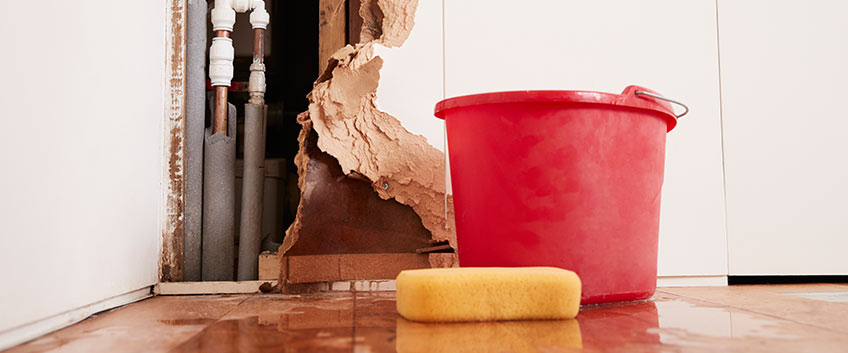
Everyone who owns or enjoys a beautiful solid wood floor knows that this type of flooring comes with several benefits and advantages and contributes to the overall cosiness, beauty, and functionality of every home. Solid wood flooring is very durable, and naturally hygienic, and increases the value of every property where it is installed. However, there is one major drawback when it comes to solid wood flooring. This type of natural flooring is prone to moisture and humidity issues and cannot withstand heavy and significant temperature fluctuations and changes in the moisture level.
Unfortunately, wood flooring and moisture are not best friends and your main mission as an owner of a beautiful wood floor is to protect it from excessive moisture, water, humidity, and temperature fluctuations, to prevent serious issues that require repair or are sometimes beyond repair. The good news is that it is not that hard and complex to prevent moisture damage and keep your solid wood floor in good condition. In this article, we will have an overview of how moisture affects solid wood flooring and how moisture damage can be prevented and avoided.
Wood Flooring’s “Movement”
Even when cut into floorboards, wood remains to respond to changes in its environment the way it will in nature. Wood has a porous structure. While some wood species are denser in structure and others have a very porous structure, all wood species come with a structure that is affected by moisture, humidity, and temperature fluctuations. When the temperature and moisture level of the floor and its environment increase, that causes the floorboards to start contracting, shrinking and expanding. This is the natural response of wood to changes. Fortunately, natural wood is very good at limiting this movement itself and soon it will be back in its natural shape.
However, if the exposure to increased moisture levels and the high temperature remains for a long time or continues increasing, the wooden floor is at serious risk of damage and issues. If the contraction of the floorboards continues for too long, the floorboards will get damaged, distressed, and even broken. Some of the most common problems caused by moisture and humidity include loose and broken boards, ballooning and cupping of the boards, issues with the finish, which can get chipped and damaged, rotten wood boards, and structural issues when the moisture problem affects the subfloor and more.
How Moisture Issues Are Prevented During Installation
Many things are done and should be done to ensure that the wooden floor won’t get damaged due to its “movement”. First of all, the installation of the floor is one of the most important stages for ensuring its structural integrity, strength, and solidness. It is very important to ensure that the subfloor is dry for an installation to be successful. In case the subfloor cannot be completely dry for some reason and usually with concrete subfloors, you are recommended to invest in the installation of a moisture barrier underlay under the floorboards or opt for engineered wood flooring and a floating installation. Additionally, it is very important to ensure the floorboards are well acclimatised to their new environment once the flooring materials are delivered on-site where the fitting is planned.
Allow at least a few days for the floorboards to get used to the new environment where they will be installed. Installation of real wood floorboards also requires the intentional creation of an expansion gap. The expansion gap is left along the perimeter of the room, a small space of a couple of centimetres between the floorboards and the wall that leaves enough room for the floorboards to expand without getting damaged. We understand you didn’t know anything about the expansion gap until now, because the gap is covered with flooring accessories like skirting boards and it is practically invisible. All these initials during the installation process help in preventing moisture damage and create a floor with a solid and sturdy structure.
Solid Wood Flooring in the Different Seasons
One very common question people are interested in when considering solid wood flooring is how it is affected by seasonal changes. At the end of the day, when seasons change, the level of humidity, moisture in the air, and, of course, temperatures change too. So how this will affect the condition of your floor? The truth is, that wood floors are designed in a way they are not significantly affected by seasonal change. In general, the floor needs to get used to the environment inside the room, where is it installed. However, some aspects can sometimes have a bit of impact on the floor.
For example, in wintertime heating can dry the floorboards out a little bit. When the wood starts losing its naturally inherent moisture, the floorboards may contract. While this contraction is most surely not going to lead to some major issues and problems you have to deal with, be aware that the dryness of the floorboards may lead to gaps occurring between the boards. Fortunately, such gaps do not hide major risks for the structural integrity and strength of the floor, but they increase the efficiency of the floor’s insulation. While back in summertime the gaps will probably disappear, if they remain you can always consider a gap filling service.
When the temperatures in summertime go up and the humidity level in the air increases, the floorboards will start absorbing moisture and they may expand. The gaps that have occurred in the wintertime will close. While this expansion of the gaps is usually not risky for the structural integrity and durability of the floor, under some extreme circumstances the floorboards may get damaged. While the process of expansion of the floorboards will reverse naturally once the temperatures and humidity level drop down if the floorboards remain “swollen” or cupping, which is the professional term, make sure to contact wood flooring professionals and ask for their help.